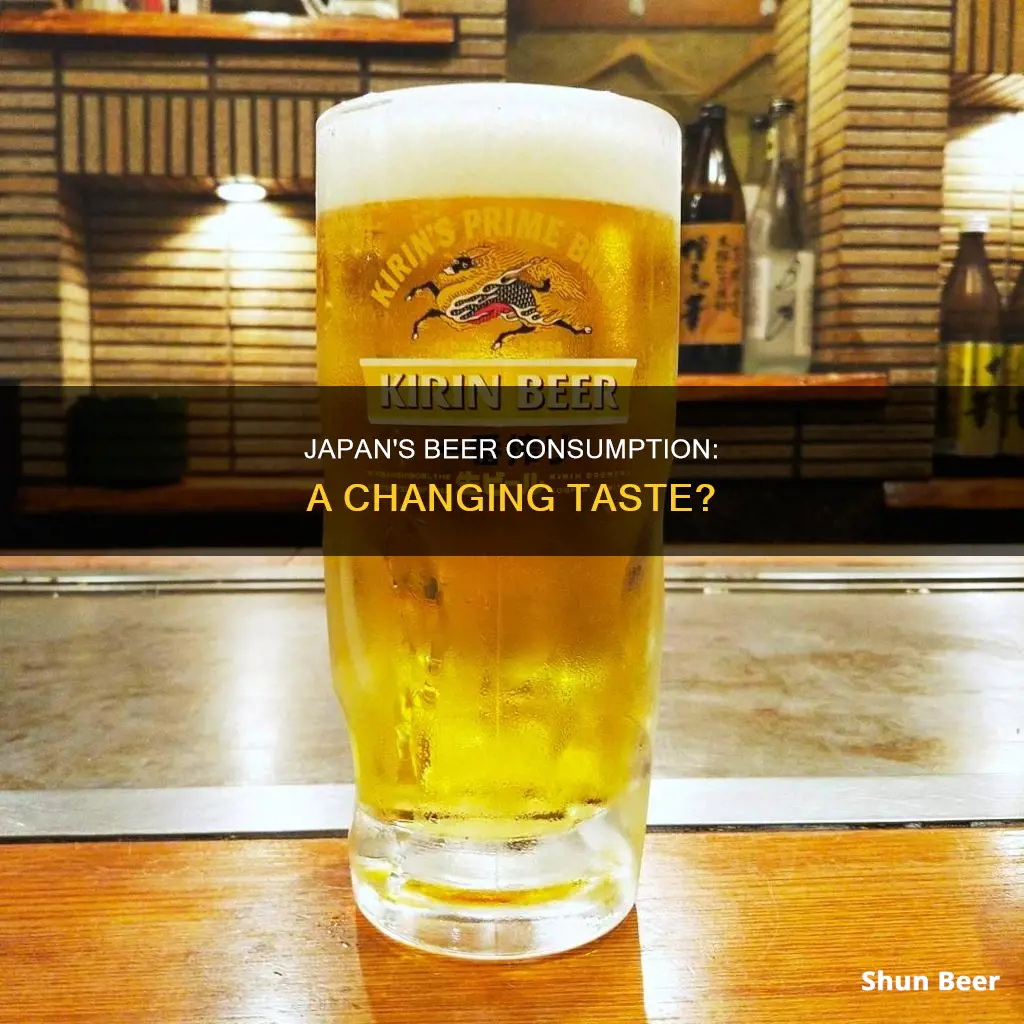
Japan has a drinking culture that is deeply ingrained in its social and business interactions. Beer is the most popular alcoholic drink in the country, with four major breweries—Asahi, Kirin, Sapporo, and Suntory—dominating the market. However, studies have shown that Japanese people are drinking less than ever, with alcohol consumption dropping steadily over the past several decades. This decline is particularly noticeable among younger generations, who are more health-conscious and less inclined to view heavy drinking as a social necessity. The rise of non-alcoholic alternatives and a growing emphasis on work-life balance are also contributing factors to the decrease in alcohol consumption in Japan.
What You'll Learn

Younger generations are drinking less beer
Younger generations in Japan are drinking less beer than their predecessors. This is a reflection of broader societal changes, including a growing emphasis on health-consciousness and maintaining a healthy work-life balance.
Japan has a rich drinking culture, with alcohol playing a significant role in both social and business interactions. Drinking parties, known as "nomikai," are a cornerstone of Japanese social and professional life, serving as informal venues for bonding and fostering open communication. However, there is a growing recognition of the need to respect individual preferences and circumstances, especially among younger generations.
Beer is the most popular alcoholic drink in Japan, with major brands such as Kirin, Asahi, and Sapporo dominating the market. However, the overall consumption of beer has been declining. This is evident from the National Tax Agency's research, which showed that alcohol consumption per person per year decreased from 108 liters in 1992 to 82.8 liters in 2013.
The decline in beer consumption among younger generations can be attributed to various factors. One reason is the increasing health consciousness among young people, who are more aware of the potential health risks associated with excessive drinking. They are less inclined to view heavy drinking as a social necessity and are more likely to make healthier choices.
Additionally, the high cost of beer and the rise of non-alcoholic alternatives have also contributed to the decrease in beer consumption. The tax changes on malt content have made regular beer more expensive compared to its less-malt-containing alternatives, such as happoshu and new-genre beer. These alternatives are taxed differently and are therefore cheaper to purchase.
Furthermore, the growing emphasis on work-life balance has also played a role in reducing beer consumption among younger generations. Some companies actively discourage excessive after-work drinking sessions, recognizing the importance of employees' personal time and well-being. The demanding nature of Japanese jobs often leaves employees exhausted, and they may opt for alternative team-building activities that don't involve drinking.
The decline in beer consumption among younger generations in Japan has had a significant impact on the beer market. While major brewers have experienced a decline in sales, there is a growing demand for locally produced craft beers and selected premium imported beers. This shift in consumption patterns presents new market opportunities for craft brewers and importers.
Beer and PEP: A Safe Mix?
You may want to see also

Beer is taxed according to malt content
Beer is the most popular alcoholic drink in Japan, but the country's drinking culture is evolving. Young Japanese consumers are drinking less beer than previous generations, and overall alcohol consumption is decreasing. This is particularly true among younger generations, who are more health-conscious and less inclined to view heavy drinking as a social necessity.
In Japan, beer is taxed according to its malt content. Regular beer with a standard malt content is taxed at a higher rate, making it more expensive than low-malt and non-malt alternatives. To address this issue, Japanese brewers have created beer-like drinks with reduced malt content, such as happoshu and new-genre beer. These beverages are taxed less, allowing them to be sold at lower prices.
Happoshu, or low-malt beer, is a recent innovation in the Japanese beer industry. It has a similar alcohol content to regular beer but is made with less malt, resulting in a lighter taste. Due to its lower malt content, happoshu is taxed at a lower rate, making it a more affordable option for consumers.
New-genre beer, also known as "third beer" or "daisan no bīru," is the latest development in this trend. To counter tax changes that increased the price of happoshu, this beverage contains no malt at all, using pea, soy, or wheat spirits instead. As a result, it can be sold at an even lower price than happoshu.
The Japanese government is in the process of unifying the tax rates on beer and beer-like beverages. The plan, introduced in 2018, aims to equalise the tax rates for all categories of beer by 2026. This will likely have a significant impact on the industry, as the price difference between regular beer and its low-malt alternatives narrows.
The changes in taxation are expected to benefit traditional beer producers in the long run. With the convergence of tax rates, consumers will no longer be incentivised to choose low-malt or no-malt beers to avoid higher taxes. This could lead to a revival of the regular beer market and potentially increase malt consumption in Japan.
Root Beer and Colonoscopy: What's the Safe Call?
You may want to see also

Beer-like drinks are taxed less
Beer-like drinks, such as happoshu and new-genre beer, are taxed less than regular beer in Japan because they contain less or no malt. This makes them cheaper to sell and, therefore, more appealing to consumers.
Happoshu, which translates to "sparkling alcohol" or "low-malt beer," is a recent invention by Japanese brewers. It has a similar flavour and alcohol content to beer but is made with less malt, giving it a lighter taste. Due to its lower malt content, happoshu is taxed differently and is, thus, less expensive.
New-genre beer, also known as "third beer" or "dai-san no bīru," is the most recent development in the Japanese beer industry. This beer-like beverage contains no malt, instead using pea, soy, or wheat spirits. As a result, it can be sold at a lower price than both regular beer and happoshu.
The emergence of these beer alternatives can be attributed to Japan's alcohol tax structure, which taxes beverages according to their malt content. Regular beer, with its higher malt content, falls into a higher tax bracket, making it more expensive for consumers.
The price difference between regular beer and its less-malt-containing alternatives is narrowing, however. The alcohol tax rate is being incrementally adjusted and will eventually be unified into a single rate for all beer and beer-like beverages by 2026. This change may favour traditional beer in the long run, as the favourable tax treatment of low-malt alternatives diminishes.
Christians Drinking Beer: Is It a Sin?
You may want to see also

Beer is the most popular alcoholic drink in Japan
Beer's popularity in Japan can be attributed to its social and cultural significance. Drinking parties, known as "nomikai," are a cornerstone of Japanese social and professional life, serving as informal venues for bonding and fostering open communication. Beer often plays a role in these gatherings as a starter drink. Additionally, the concept of "nominication," a blend of the Japanese word "nomu" (to drink) and "communication," highlights the perceived importance of alcohol in facilitating social interactions and building trust.
The rise in beer's popularity in Japan can be traced back to the second half of the 20th century, when it overtook sake as the nation's favourite drink. This shift may be due to the introduction of new types of beer-like beverages, such as "happoshu" and "new-genre beer," which are taxed less due to their lower malt content and are therefore more affordable.
However, it is important to note that Japan's drinking culture is complex and multifaceted. While beer is the most popular alcoholic beverage, Japan offers a diverse range of drinks, including sake, shochu, whisky, and umeshu. Additionally, there is a growing trend towards craft beer and microbreweries, with Tokyo and Osaka boasting vibrant craft beer scenes.
Passover Beer: What Jews Can Drink and Avoid
You may want to see also

Drinking is a cornerstone of Japanese social and professional life
In Japan, drinking parties are typically held at restaurants and "izakaya" (Japanese-style pubs). A wide variety of alcoholic beverages are consumed, including beer, sake, shochu, whisky, and umeshu. Beer is the most popular alcoholic drink in Japan, with major brands such as Kirin, Asahi, and Sapporo producing pale lagers that are immensely popular. However, due to taxation issues, beer-like beverages with lower or no malt content, known as "happōshu" or "new-genre" beers, have also captured a large part of the market. These drinks are taxed less and are therefore sold at lower prices.
The role of alcohol in Japanese business and social relationships is significant. Many Japanese believe that missing out on after-work drinking sessions can hinder career progression. This is because managers often use these informal settings to assess employees' personalities and teamwork skills, and those who participate regularly may find it easier to build relationships with superiors. However, this culture has faced criticism for potentially excluding those who don't drink or have family commitments, and there is a growing emphasis on maintaining a healthy work-life balance.
While drinking is an integral part of Japanese culture, there is also increasing awareness of its potential health risks. The Japanese government has implemented initiatives to address alcohol-related health issues, and there has been a rise in non-alcoholic alternatives. Overall alcohol consumption in Japan has been decreasing, particularly among younger generations who are more health-conscious and less inclined to view heavy drinking as a social necessity.
Liquor After Beer: Is It Safe?
You may want to see also
Frequently asked questions
There are several reasons why Japanese people are drinking less beer. Firstly, younger generations are more health-conscious and less inclined to view heavy drinking as a social necessity. Secondly, there is a growing emphasis on maintaining a healthy work-life balance, with some companies actively discouraging excessive after-work drinking sessions. Finally, the rise of non-alcoholic alternatives and the increasing recognition of the "Asian flush" – a genetic condition common among East Asians that causes facial redness when consuming alcohol – have provided individuals with more options to participate in social drinking customs without consuming alcohol.
The standard type of beer in Japan is light lager beers with an alcohol content of around five percent. However, there are also several beer-like beverages that have emerged due to taxation issues. These include happoshu, which is similar in flavour and alcohol content to beer but contains less malt, and new genre beer, which contains no malt and is instead made with pea, soy or wheat spirits.
Drinking plays an important role in Japanese society and is deeply ingrained in social and business interactions. Nomikai, or drinking parties, are a cornerstone of Japanese social and professional life, serving as informal venues for colleagues and friends to bond outside of formal settings. Alcohol is also easily accessible in Japan, with hard spirits sold in convenience stores and vending machines. It is even legal to drink in public, making it common to see people consuming alcohol in parks, on the train, or at the beach.







